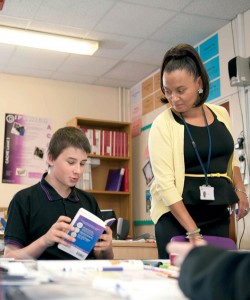Today you will
Develop strategies to improve fluency and confidence in speaking develop an understanding of the elements necessary for an effective presentation.
Many students suffer from a huge lack of confidence when it comes to speaking at key stage 4. They may struggle to respond to questions or comments in the target language and to use it spontaneously themselves. Even with time and resources to prepare for GCSE controlled assessments, they often find it difficult to come up with ideas, to anticipate the kind of questions to expect, and to ‘think on their feet’.
Taking them through a series of activities leading up to a presentation to ‘sell’ a Chindogu invention (the Japanese art of inventing everyday gadgets that ostensibly offer a solution to a problem but in fact create more issues than they solve!) is one way of helping them to develop greater confidence in speaking and to think creatively.
Starter Activity
Show the students a Wordle (word cloud created at wordle.net) of a definition of Chindogu in the target language. This can be found on the relevant language page on Wikipedia and could be simplified or edited if necessary. Get them to pick out as many words as they can that they recognise and to categorise the vocabulary (e.g. adjectives such as useful, practical, modern, new, everyday and nouns such as objects, gadgets, solutions and problems).
Explain to the students that they are going to be working towards a presentation to ‘sell’ a Chindogu invention and will be engaged in a series of activities that will involve them in brainstorming ideas and expressing them in sentences that use a range of vocabulary and structures; skills that can be transferred to other contexts when they come to do their controlled speaking assessments.
Main activities
1. Compare and contrast
Show your students images of at least nine examples of Chindogu, such as a device to cool noodles, a 10 in 1 gardening tool, duster slippers for a cat, an umbrella tie, a portable toilet paper dispenser, umbrellas for shoes and so on, all of which can be found with a simple Google search. Project these onto the whiteboard or give them to the students on cards. Tell them to work in pairs to rank the inventions according to what they like the most/least in a ‘diamond nine’ activity. They should be encouraged to use the target language exclusively when discussing this; if, for example they don’t know the French/German/Spanish for a particular word encourage them to ask each other in the language, e.g. “How do you say “xxx” in xxx?” Encourage them to use the target language as much as possible either by incentivising its use through awarding points or equivalent, or by issuing ‘penalty points’ for use of English. Once learners have done this, get them to compare their choices with another pair or group, encouraging them to make comparisons in the target language: “What have you chosen? Why? Because… We think that… Would you ... if…” Depending on the ability of the group it may be necessary to give them a prompt sheet with some key vocabulary.
Then get the students to come up with a description of their favourite item. You could point out that although they may not know what to call the object in the target language most of the gadgets relate to everyday activities so they will be using that kind of vocabulary. You could model, for example, the following definition of a torch in the target language: “It’s useful in the dark. It can be quite small. You need batteries for it. Sometimes you can wear it on your head etc”. Identify with your students which words or phrases in the above example could be applied to any context; words like need, can be, sometimes etc. Challenge them to come up with some other useful high frequency phrases and write these on the board before they start on the task. At this stage try to get them to do as much as possible without using dictionaries – the aim is to show them how much they can do with the words they know.

2. Make the case
Tell the students that they are going to be working in groups of four and will be allocated one of the items (a random draw from a hat is probably the best way of doing this); they will have to try to persuade their audience that their object is more important/useful than any of the others. At this stage show the class the criteria against which the task will be assessed – this should be based on GCSE speaking assessment criteria and could consist of a tick list. The students should then brainstorm in their groups to produce a mind map of useful vocabulary and phrases related to their object, using dictionaries where necessary. Suggest that they group their vocabulary in categories such as verbs, adjectives and so on. They should also think ‘outside the box’, about who could potentially use the object and how and when it could be used, and should ensure that they have the appropriate vocabulary. For weaker groups of students you may need to model the kind of mind map they could produce by using another object.
3. Card tricks
Once they have got their bank of vocabulary give each student a sheet of A4 paper and get them to produce 16 small cards from it. Students should then write a word or phrase from the mind map onto each card. They work in pairs talking about their object and trying to use as many of the words on their cards as possible, turning them over or removing them to a separate pile as they use them. The object is to be the first to ‘spend’ all the words. To make this more challenging you could get students to swap cards so that they are working with a partner’s choices. Tell them to save their cards for a later activity…
4. Are you asking?
The next stage is to point out to the students that, in order to make their case, they may also want to pose rhetorical questions. See if your class can come up with some examples; failing that give them a series of starters in the target language such as “Do you want…”, “Have you…?” “Can you…?” “Why not…” “Isn’t it…?” “What would you…?” “If you want to…?” and challenge them to come with as many examples related to their item as possible. Get the pupils to write them down and give them some time to practise their pronunciation; this will give you an opportunity to identify any words, sounds or structures that are problematic that you may want to pick up on and practise with the whole class.
5. Rolling with it
The next challenge for the students is to practise using the words they identified and wrote on cards in the earlier activity with the range of tenses, subordinate clauses, conjunctions, adverbs and so on, that they would be expected to employ at GCSE. This can be done as a dice activity in pairs, but swapping partners from the previous activity. Project a 6 x2 grid onto the whiteboard – the top row has images of dice 1 – 6 and the second row has a verb tense (e.g. past, present, future, conditional, imperfect and pluperfect) or a phrase like ‘there is’ or a time phrase in the grid. Students use the cards from the previous activity shuffled into a pack and face down. They roll a die and pick a card to make a sentence relating to their object using both the word on the card and the tense from the die. There is scope for differentiation here with a third or even fourth row for the more able, with other grammatical structures such as adjective agreements, comparative, superlative, adverb or containing specific conjunctions and so on. As you go around ‘eavesdropping’, note some good examples, which can be fed back to the whole class.
6. The hard sell

Finally, the students should be given some time to prepare a short individual presentation, which they should practise giving to each other in the group. If they write out a script they should identify the key words and deliver the presentation using just a bulleted list. They should give each other feedback using the tick sheet or criteria discussed earlier and should also be encouraged to engage in self assessment, identifying what went well and what they would need to do to further improve their performance. If facilities and time allow the students could film each other, and these short videos could be uploaded onto the school’s VLE so that all students are able to watch them.
Home learning
• Students could be asked to review their presentation in the light of the feedback they received and try to anticipate some questions they could be asked about the object. If videos have been uploaded onto the school’s VLE they could look at their peers’ presentations and make a note of positive features, which they could consider incorporating into their next speaking task. They could vote for the ‘best presentation’ via a free online survey tool.
• Students prepare for a controlled speaking task which involves a presentation (see ‘stretch them further’ for ideas of different contexts).
Summary
To round up the lesson the class could play the game ‘You say we pay’, an activity that allows them to transfer some of the skills they have practised during the lesson to a different situation. In this game a student volunteer faces the class with an image of an everyday object projected onto the board behind him/her. He/she has to guess what this is from the description given by the members of the class. He/she can ask questions, but only those that can be answered with ‘yes’ or ‘no’.
Info bar
Stretch them further
This activity could be adapted to any context, such as holiday destinations, best books to read, films to see or even apps for mobile phones. It could also be developed into a whole day ‘enterprise’ type activity with the students producing a more comprehensive advertising campaign for their item and being subjected to a Dragon’s Den type scenario of presentation and questioning.
About the expert
Liz Fotheringham is an experienced MFL teacher, former regional subject adviser for the secondary curriculum and trainer with the Network for languages.










